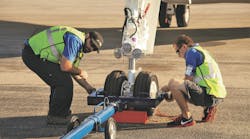Notes from Inside the Industry
By Stan Mackiewicz
June 1999
This refrain from "Old Man River" sums up any estimate of what will happen with the Notice for Proposed Rulemaking for Part 66 Certification of Mechanics. "Nobody knows" includes those who are supposed to know, think they know, and those actually in charge. This is not a reflection on them as individuals, but is representative of the rulemaking system.
It seems that every person, place, or thing can affect a rule as it winds its way through the pothole scattered labyrinth process called rulemaking. As soon as you think the procedure is comprehendible, the government and industry players all change and a re-education process begins again.
Something will have to happen. Internal FAA, DOT, and other agency management reporting systems carry the project. Once something is on those tracking documents, it is virtually impossible to remove them entirely. To do so, someone must admit the project failed causing an outside look at "why." Therefore, someone must do something.
This is what PAMA would like to see happen:
• Put recurrent training in the rule One day per year of training is not too much to ask in the name of aviation safety.
• Certify Maintenance Instructors
• Extend IA renewal to 24 months
• Registration every 4 years
• Revise the Change of Address proposal
For the moment, one thing is certain. The public has spoken. They have spoken to the tune of 2,200 comments.
Technician shortage: A surprise?
Throughout the aviation industry today, PAMA hears this question asked over and over again — "Where can I find qualified aviation
maintenance technicians?"
Why is a shortage of talent a surprise, when in today's world of record low unemployment, high competition for technical skills, and the lowest level of 20 to 24 year olds in the workforce since 1976, that talent is scarce?
PAMA strives to inform, support, and represent the individual aviation maintenance professional (AMP). Therein resides somewhat of a dilemma. Is aggressively pursuing a solution to the AMT shortage in the best interest of the current body of working professionals? Or, should PAMA (and maintenance trade publications) allow the law of supply and demand take its course? Should PAMA proffer opportunities for "alternative" careers for experienced AMPs i.e., mass transit, theme parks, or automotive industry-based technical careers?
Just as there are a multitude of reasons people choose a career, there are a multitude of opinions on how to respond to the technician shortage. A zealous telling of the behind-the-scenes story by those contributing to aviation safety and efficiency (to the flying public) may attract some new blood to the industry, but more importantly, the knowledge will boost the self-image and self-esteem of those currently in maintenance professions. Letting the membership or readership know that they are wanted and needed by other industries is positive reinforcement from within the industry of their worth, thus encouraging remedies to whittle away at the technician shortage.
The industry must focus on retaining and developing those who have already committed to a career in aviation — especially aviation maintenance and avionics. Take care of the current work force with competitive value-based compensation, with professional leadership and with technology-based educational programs. Do this and today's aviation maintenance professional will become the industry's most vocal advocate and in turn, attract those with the right stuff to fill tomorrow's aviation career opportunities.
Alerts
As you recall, the General Aviation Alerts Bulletin (AC 43-16) became
unavailable last December in printed form, except from what could be downloaded from the Web. In typical fashion of "Fire, aim, draw," the FAA now admits that the bulletin is worthwhile in printed form and will be sold as a subscription by the Government Printing Office. The turnabout still leaves five months of information unavailable to the aviation community. The budget money needed to fill the gap was a mere $10,000 a month. When an agency does not have such a paltry sum of discretionary funds in order to publish safety information, one must wonder what else was killed that we did not see. The agency should be reminded that starting something that is stopped often costs 10 times what it cost if they had not stopped it in the first place.
The letter PAMA received from the FAA on the subject has a cautionary warning. It said "The actual number of reports published in the Alerts is less than five percent of those reported, leaving a significant amount of safety information not reported through the Alerts. All reports received are published in an Internet form each month. The General Aviation Maintenance Alerts are informative, but aviation professionals responsible for airworthiness should be researching all available service information." Lawyers take note.





